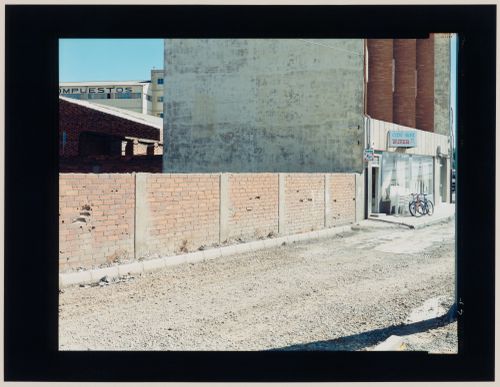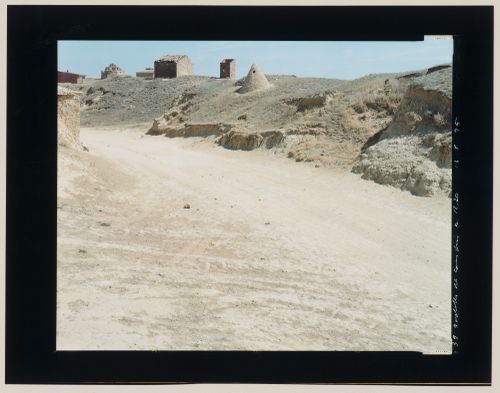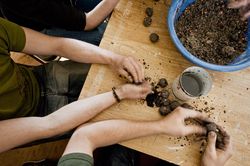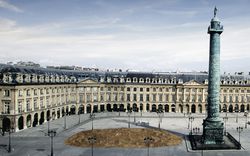PHCON2002:0016:013:006:001
1972
photographs
Plateau of cleared land with tire tracks in dirt, overlooking a town in a, Glendale, California
PH1980:1184
1980
Plateau of cleared land with tire tracks in dirt, overlooking a town in a, Glendale, California
Actions:
PH1980:1184
photographs
1980
Rear of "recently occupied" stucco house showing patio and dirt backyard, Diamond Bar, California
PH1985:0200
1980
Rear of "recently occupied" stucco house showing patio and dirt backyard, Diamond Bar, California
Actions:
PH1985:0200
PH1984:0468
printed ca. 1900
Wooden house with porch, barn adjacent, dirt track and wooden fence in foreground, New York State [?]
Actions:
PH1984:0468
PH2003:0128
architecture, engineering
August 1995
View of a café and other buildings, a brick wall and a dirt road, León, León Province, Spain
Actions:
PH2003:0128
architecture, engineering
PH1997:0054
Description:
The series "Running Fence 1997" focuses "on the first 14 miles of the border fence that separates the United States and Mexico, beginning at the Pacific Ocean and ending in the Otay Mountains.... [It] analyzes the "idea" of the border and explores its iconography, the border being a subject that is of extreme importance to the public as the world proceeds towards greater globalization. [Geoffrey] James has written of the project: "[The border fence] was built by the US Army Corps of Engineers in 1994, out of recycled metal landing strip - the most visible symbol of what is known as Operation Gatekeeper. Because the steel sheets are placed in the ground so that their ridges run horizontally, a man can hop over the fence with ease; and no Mexican child ever seems to be impeded from retrieving a soccer ball from US territory. The real barrier to illegal immigration from Mexico into the USA is less visible: hundreds of buried sensors linked to a central computer, nightscopes, helicopters and Border Patrol Agents in white Broncos."" (Evans).
architecture, engineering
1997
View of dirt road and dwelling showing a partial view of United States-Mexico border fence, San Diego County, California, United States and Colonia Libertad, Tijuana, Baja California, Mexico
Actions:
PH1997:0054
Description:
The series "Running Fence 1997" focuses "on the first 14 miles of the border fence that separates the United States and Mexico, beginning at the Pacific Ocean and ending in the Otay Mountains.... [It] analyzes the "idea" of the border and explores its iconography, the border being a subject that is of extreme importance to the public as the world proceeds towards greater globalization. [Geoffrey] James has written of the project: "[The border fence] was built by the US Army Corps of Engineers in 1994, out of recycled metal landing strip - the most visible symbol of what is known as Operation Gatekeeper. Because the steel sheets are placed in the ground so that their ridges run horizontally, a man can hop over the fence with ease; and no Mexican child ever seems to be impeded from retrieving a soccer ball from US territory. The real barrier to illegal immigration from Mexico into the USA is less visible: hundreds of buried sensors linked to a central computer, nightscopes, helicopters and Border Patrol Agents in white Broncos."" (Evans).
architecture, engineering
PH2003:0127
architecture, engineering
August 1995
architecture, engineering
Project
Copper House II
AP182.S1.2009.D1
Description:
File documents an executed project for a private house in Chondi, Maharashtra, India. Copper House II is the second residence of a couple from Mumbai, who visit the house for a few days each week. It is located in a dense grove of mango trees near a brook that floods each year during the monsoon. To protect the inhabitants from the encroaching landscape, the house is set on an artificial high ground made of dirt dug for a well from the site itself. The open-air courtyard at the centre of the plan is paved in black basalt stones that also allow rainwater to drain below the house. On the ground floor, large horizontal windows are sheathed in slatted ironwood and copper mesh, providing a form of camouflage for the house while still permitting views out from the living spaces. The two boxy spaces upstairs are private: one contains a master bedroom and study, the second a smaller bedroom. The thin copper sheets that cover the upper floor are waterproof and will develop a verdigris over time, further concealing the house within its setting. File contains drawings, photographs, models, and a video recording.
2009-2014
Copper House II
Actions:
AP182.S1.2009.D1
Description:
File documents an executed project for a private house in Chondi, Maharashtra, India. Copper House II is the second residence of a couple from Mumbai, who visit the house for a few days each week. It is located in a dense grove of mango trees near a brook that floods each year during the monsoon. To protect the inhabitants from the encroaching landscape, the house is set on an artificial high ground made of dirt dug for a well from the site itself. The open-air courtyard at the centre of the plan is paved in black basalt stones that also allow rainwater to drain below the house. On the ground floor, large horizontal windows are sheathed in slatted ironwood and copper mesh, providing a form of camouflage for the house while still permitting views out from the living spaces. The two boxy spaces upstairs are private: one contains a master bedroom and study, the second a smaller bedroom. The thin copper sheets that cover the upper floor are waterproof and will develop a verdigris over time, further concealing the house within its setting. File contains drawings, photographs, models, and a video recording.
Project
2009-2014
Making Seed Bombs
Montréal-based artist Gina Badger shows workshop participants how to make seed-bombs – balls of dirt, clay, water, and seeds that can be used to start gardens in the city. The workshop is presented in collaboration with DARE-DARE (Centre de diffusion d’art multidisciplinaire de Montréal). In conjunction with the exhibition Actions: What You Can Do With the City (2008),(...)
14 March 2009
Making Seed Bombs
Actions:
Description:
Montréal-based artist Gina Badger shows workshop participants how to make seed-bombs – balls of dirt, clay, water, and seeds that can be used to start gardens in the city. The workshop is presented in collaboration with DARE-DARE (Centre de diffusion d’art multidisciplinaire de Montréal). In conjunction with the exhibition Actions: What You Can Do With the City (2008),(...)
articles
Let us assure you
Vendôme, mound of Vendôme, Commune de Paris, Paris, revolution, landscape, dirt, column, Napoleon, destruction, urban symbols, urban imaginary
28 February 2016
Let us assure you


![Wooden house with porch, barn adjacent, dirt track and wooden fence in foreground, New York State [?]](/img-collection/2uqKSFRj3CcEGn4zEmKmbab9_yw=/500x375/360590.jpg)




